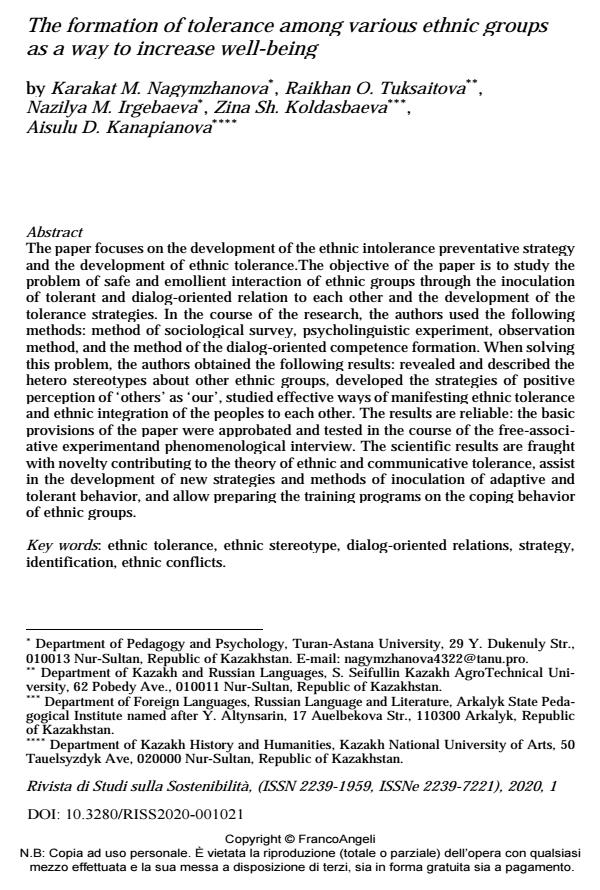The formation of tolerance among various ethnic groups as a way to increase well-being
Journal title RIVISTA DI STUDI SULLA SOSTENIBILITA'
Author/s Karakat M. Nagymzhanova, Raikhan O. Tuksaitova, Nazilya M. Irgebaeva, Zina Sh. Koldasbaeva, Aisulu D. Kanapianova
Publishing Year 2020 Issue 2020/1
Language English Pages 18 P. 353-370 File size 164 KB
DOI 10.3280/RISS2020-001021
DOI is like a bar code for intellectual property: to have more infomation
click here
Below, you can see the article first page
If you want to buy this article in PDF format, you can do it, following the instructions to buy download credits

FrancoAngeli is member of Publishers International Linking Association, Inc (PILA), a not-for-profit association which run the CrossRef service enabling links to and from online scholarly content.
The paper focuses on the development of the ethnic intolerance preventative strategy and the development of ethnic tolerance.The objective of the paper is to study the problem of safe and emollient interaction of ethnic groups through the inoculation of tolerant and dialogoriented relation to each other and the development of the tolerance strategies. In the course of the research, the authors used the following methods: method of sociological survey, psycholinguistic experiment, observation method, and the method of the dialog-oriented competence formation. When solving this problem, the authors obtained the following results: revealed and described the hetero stereotypes about other ethnic groups, developed the strategies of positive perception of ‘others’ as ‘our’, studied effective ways of manifesting ethnic tolerance and ethnic integration of the peoples to each other. The results are reliable: the basic provisions of the paper were approbated and tested in the course of the free-associative experimentand phenomenological interview. The scientific results are fraught with novelty contributing to the theory of ethnic and communicative tolerance, assist in the development of new strategies and methods of inoculation of adaptive and tolerant behavior, and allow preparing the training programs on the coping behavior of ethnic groups.
Keywords: Ethnic tolerance, ethnic stereotype, dialog-oriented relations, strategy, identification, ethnic conflicts.
Karakat M. Nagymzhanova, Raikhan O. Tuksaitova, Nazilya M. Irgebaeva, Zina Sh. Koldasbaeva, Aisulu D. Kanapianova, The formation of tolerance among various ethnic groups as a way to increase well-being in "RIVISTA DI STUDI SULLA SOSTENIBILITA'" 1/2020, pp 353-370, DOI: 10.3280/RISS2020-001021